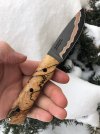- Joined
- Feb 3, 2022
- Messages
- 8
Hey fellas. Ordered a piece of spalted maple from a reputable wood dealer. Had wood shipped to knife maker. Get finished knife to me, and after a few days, I notice the wood is developing cracks. In multiple places. Maker was great about it and said send it back and he’d try and repair or replace with Micarta no charge. Bit of a hassle as I am in Canada and the wood guy and maker are in the US.
My question is if the wood is stabilized, should it be developing cracks, and should the gentleman who sold and stabilized the wood stand behind it and replace with another set of scales?
I am new to this whole game and ask this question out of complete sincerity as I don’t really know. Those scales cost me near $100 cdn to get to the maker to start with, and shipping back to the maker is gonna run me some more $.
How would you fellas handle? Would you bother approaching the wood guy or am I on my own and just swallow hard?
Thanks in advance.
PS: Please don’t ask for names, as I am not trying to slander anyone. Just asking an honest question.
My question is if the wood is stabilized, should it be developing cracks, and should the gentleman who sold and stabilized the wood stand behind it and replace with another set of scales?
I am new to this whole game and ask this question out of complete sincerity as I don’t really know. Those scales cost me near $100 cdn to get to the maker to start with, and shipping back to the maker is gonna run me some more $.
How would you fellas handle? Would you bother approaching the wood guy or am I on my own and just swallow hard?
Thanks in advance.
PS: Please don’t ask for names, as I am not trying to slander anyone. Just asking an honest question.

